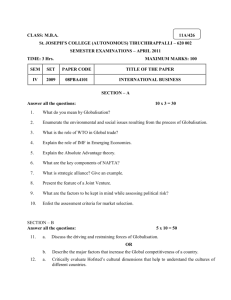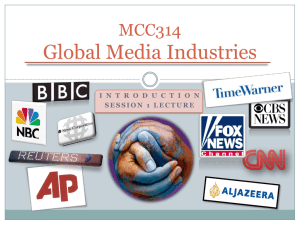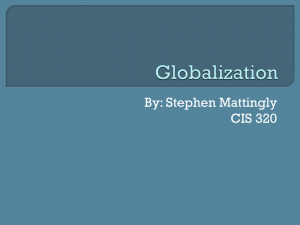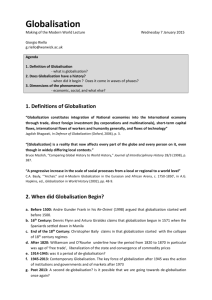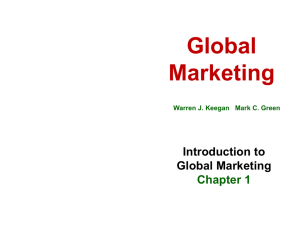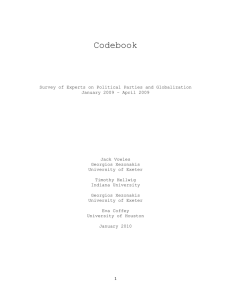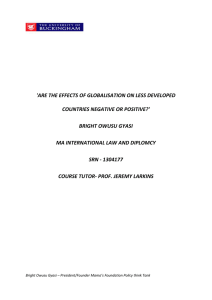What is International business? - Oman College of Management
advertisement
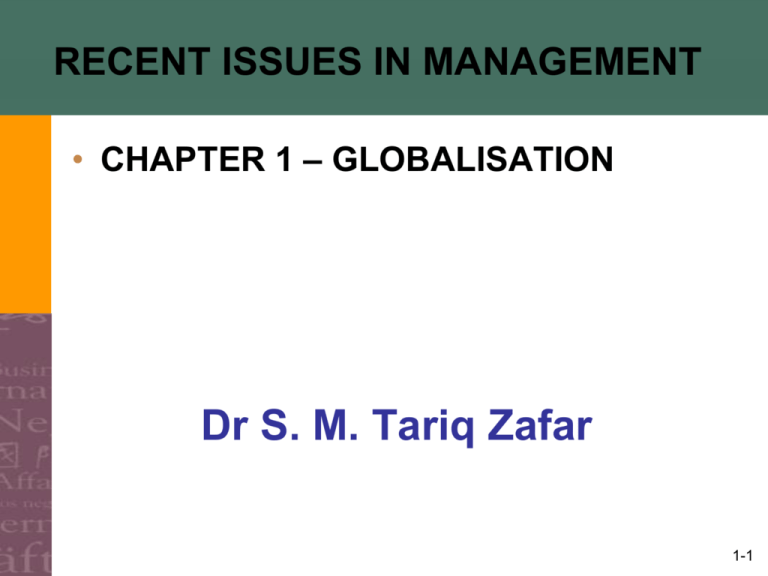
RECENT ISSUES IN MANAGEMENT • CHAPTER 1 – GLOBALISATION Dr S. M. Tariq Zafar 1-1 X Learning Outcomes • What is Globalization? • What is International business? • How does Evolution of International Business took place? • Why do companies do International Business? • What are Multinational Companies (MNCs)? • What are the different Approaches (Orientations) followed by Multinational Companies (MNCs)? • How international business differs from domestic business? • What are different types of International Business? • What are the factors which affect International Business? 1-2 Globalization • Globalisation can be defined as the free movement of goods, services and capital According to Theodore Levitt “as if the entire world (or major regions of it) were a single entity; [such an organization] sells the same things in the same way everywhere” • Economic Globalization – International integration of goods, technology, information, labor, and capital – Process of making this integration happen 1-3 X Globalization • Globalisation also involves the transfer of information, skilled employee mobility, the exchange of technology, financial funds flow and geographic arbitrage between developed countries and developing countries. • Globalisation affects the economy, business life, society and environment in different ways: • • Increasing competition, • • Technological development, • • Knowledge/Information transfer, • • Portfolio investment (fund transfer between developed countries and emerging markets), • • Market integration, 1-4 International Business – A business whose activities are carried out across national boundaries. – International business comprises all commercial transactions (private and governmental, sales, investmen ts, logistics, and transportation) that take place between two or more regions, countries and nations beyond their political boundaries. – Transaction of economic resources include capital, skills, people etc. for international production of physical goods and services such as finance, banking, insurance, construction etc. 1-5 Evolution of International Business • International Business was carried out from long back. When there was no currency people used to exchange Goods to follow Barter System (Exchange). History reveals that Sailors like Marco Polo, Columbus, Magellan, Vasco De gama on their voyage carry precious objects for exchange with other countries products. International Business gain pace after the Industrial Revolution . 1-6 X Evolution of International Business • Early traders – Well before the time of Christ, Phoenician and Greek merchants – China stimulated the emergence of an internationally integrated trading system • “all roads lead to China” • 17th Century mercantilism/colonialism – British East India Company – Dutch East India Company – Portugal and France 1-7 Why do companies do International Business (1)Pull Factors: (a) Profit Advantage : IB could be more profitable than the domestic. But if not profitable than Total Profit would be increase & thus it become again profitable. (b) Growth opportunities: · To increase sales · To increase market share of the firms 1-8 Why do companies do International Business 2) Push Factors: It refers to the compulsion of the domestic market such as saturation of the market, which prompt companies to internationalize. a) Competition: Increase competition in domestic market is one of the main cause & consequences of globalization. b) Domestic market constraints: 1-9 Why do companies do International Business · Surplus production in home market · Decline the demand of the domestic product in the home market · Small domestic market in size or limited home market · To take the benefit of economies of scale by producing mass production c) Political Stability Vs. Political Instability 1-10 Multi National Company Multi National Company - an organization having businesses in two or more than two countries – an organization that attempts to standardize and integrate operations worldwide in most of all functional areas – An organization with multi-country affiliates formulates its own business strategy on perceived market differences 1-11 X National origin of largest multinational Factors affecting International Business 1-12 EPRG Orientations 1. Ethnocentric Approach - (home country orientation) Here home country strategies are carried forward to other countries. 2. Polycentric Approach – (host country orientation) Here strategies are adopted with respect to host country 3. Regiocentric Approach – (region orientation) Here strategies are for one specific region. Example GCC 4. Geocentric Approach – (global orientation) Here companies adopt global strategy. 1-13 Why International is Different from Domestic Business? • Domestic Environment – All the uncontrollable forces in the home country that surround and influence the firm’s life and development • Foreign Environment – All the uncontrollable forces originating outside the home country that surround and influence the firm • different values • difficult to assess • interrelated 1-14 Why Is International Business Different? cont’d. • International Environment – Interaction between domestic and foreign environmental forces or between sets of foreign environmental forces – Increased complexity for decision-making • Decision making more complex 1-15 Types of International Business 1. Foreign Direct Investment - Direct investment in equipment, structures, and organizations in a foreign country. FDI is practiced by companies in order to benefit from cheaper labor costs, tax exemptions, and other privileges in that foreign country. 2. Exporting – transportation of any domestic good/service to a destination outside a country or region. Exporting is the practice of shipping goods from the domestic country to a foreign country. 1-16 Types of International Business • 3. Importing - Imports are the inflow of goods and services into a country's market for consumption. • 4. Licensing / Franchising - Licensing gives a licensee certain rights or resources to manufacture and/or market a certain product in a host country. Example - Nike goods produced in china • Franchising is the practice of licensing another firm's business model as an operator. Example - McDonalds 1-17 Types of International Business • 5. Joint Venture - In a joint venture business model, two or more parties agree to invest time, equity, and effort for the development of a new shared project. Example – Sony Ericcson • 6. Turnkey Projects – A Company takes a project in a foreign country on BuiltOperate-Transfer (BOT) condition. Example – Refinery building 1-18 Types of International Business • 7. Contract Manufacturing - In contract manufacturing, a hiring firm makes an agreement with the contract manufacturer to produce and ship the hiring firm's goods. • 8. Outsourcing - business functions to developing foreign countries has become a popular way for companies to reduce cost. 1-19 X Factors affecting International Business • Environment – All the forces influencing the life and development of the firm • Forces – External Forces (Uncontrollable) – Forces over which management has no direct control – Internal Forces (Controllable) – Forces that management can use to adapt to external forces 1-20 X Factors affecting International Business • Economic – GNP, unit labor cost, personal consumption expenditure – Interest rates, inflation rates, taxation – For distributing goods and services - Capital, raw materials, and people • Cultural – Attitudes, beliefs, and opinions – Characteristics of human population 1-21 X Factors affecting International Business • Legal – Laws governing how international firms must operate • Physical – Topography, climate, and natural resources • Political – Forms of government, and international organizations • Technological – Equipment and skills that affect how resources are converted to products 1-22 X Assignment No. 1 • You are to select any two Multinational Companies (MNC’s) of your choice belonging to different segments. Prepare a report under the following heads: • 1. Introduction • 2. Products (any 5) • 3. Countries where they are doing business (any 10) 1-23
